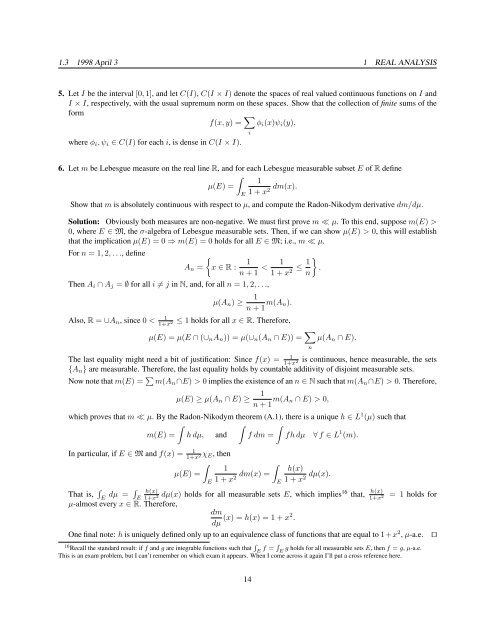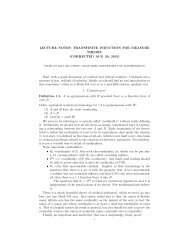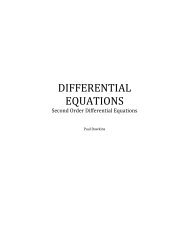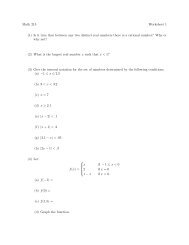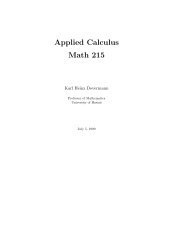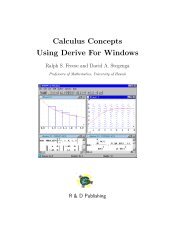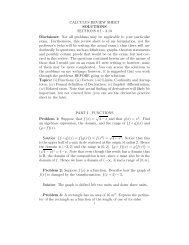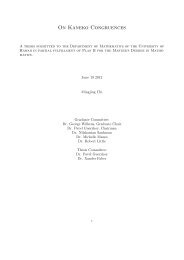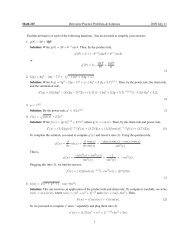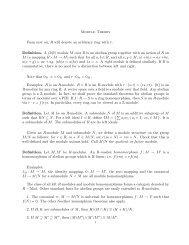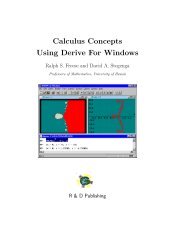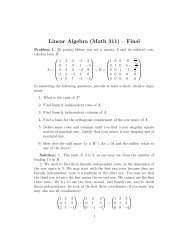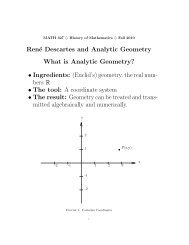Problems and Solutions in - Mathematics - University of Hawaii
Problems and Solutions in - Mathematics - University of Hawaii
Problems and Solutions in - Mathematics - University of Hawaii
Create successful ePaper yourself
Turn your PDF publications into a flip-book with our unique Google optimized e-Paper software.
1.3 1998 April 3 1 REAL ANALYSIS<br />
5. Let I be the <strong>in</strong>terval [0, 1], <strong>and</strong> let C(I), C(I × I) denote the spaces <strong>of</strong> real valued cont<strong>in</strong>uous functions on I <strong>and</strong><br />
I × I, respectively, with the usual supremum norm on these spaces. Show that the collection <strong>of</strong> f<strong>in</strong>ite sums <strong>of</strong> the<br />
form<br />
f(x, y) = <br />
φi(x)ψi(y),<br />
where φi, ψi ∈ C(I) for each i, is dense <strong>in</strong> C(I × I).<br />
6. Let m be Lebesgue measure on the real l<strong>in</strong>e R, <strong>and</strong> for each Lebesgue measurable subset E <strong>of</strong> R def<strong>in</strong>e<br />
<br />
1<br />
µ(E) = dm(x).<br />
1 + x2 E<br />
Show that m is absolutely cont<strong>in</strong>uous with respect to µ, <strong>and</strong> compute the Radon-Nikodym derivative dm/dµ.<br />
i<br />
Solution: Obviously both measures are non-negative. We must first prove m ≪ µ. To this end, suppose m(E) ><br />
0, where E ∈ M, the σ-algebra <strong>of</strong> Lebesgue measurable sets. Then, if we can show µ(E) > 0, this will establish<br />
that the implication µ(E) = 0 ⇒ m(E) = 0 holds for all E ∈ M; i.e., m ≪ µ.<br />
For n = 1, 2, . . ., def<strong>in</strong>e<br />
An =<br />
<br />
x ∈ R :<br />
1<br />
n + 1 <<br />
Then Ai ∩ Aj = ∅ for all i = j <strong>in</strong> N, <strong>and</strong>, for all n = 1, 2, . . .,<br />
µ(An) ≥ 1<br />
n + 1 m(An).<br />
1<br />
<br />
1<br />
≤ .<br />
1 + x2 n<br />
Also, R = ∪An, s<strong>in</strong>ce 0 < 1<br />
1+x2 ≤ 1 holds for all x ∈ R. Therefore,<br />
µ(E) = µ(E ∩ (∪nAn)) = µ(∪n(An ∩ E)) = <br />
µ(An ∩ E).<br />
The last equality might need a bit <strong>of</strong> justification: S<strong>in</strong>ce f(x) = 1<br />
1+x 2 is cont<strong>in</strong>uous, hence measurable, the sets<br />
{An} are measurable. Therefore, the last equality holds by countable additivity <strong>of</strong> disjo<strong>in</strong>t measurable sets.<br />
Now note that m(E) = m(An∩E) > 0 implies the existence <strong>of</strong> an n ∈ N such that m(An∩E) > 0. Therefore,<br />
µ(E) ≥ µ(An ∩ E) ≥ 1<br />
n + 1 m(An ∩ E) > 0,<br />
which proves that m ≪ µ. By the Radon-Nikodym theorem (A.1), there is a unique h ∈ L1 (µ) such that<br />
<br />
<br />
m(E) = h dµ, <strong>and</strong> f dm = fh dµ ∀ f ∈ L 1 (m).<br />
In particular, if E ∈ M <strong>and</strong> f(x) = 1<br />
1+x2 χE, then<br />
<br />
<br />
1<br />
h(x)<br />
µ(E) = dm(x) = dµ(x).<br />
E 1 + x2 E 1 + x2 That is, h(x)<br />
dµ = E E 1+x2 dµ(x) holds for all measurable sets E, which implies16 that, h(x)<br />
1+x2 = 1 holds for<br />
µ-almost every x ∈ R. Therefore,<br />
dm<br />
dµ (x) = h(x) = 1 + x2 .<br />
One f<strong>in</strong>al note: h is uniquely def<strong>in</strong>ed only up to an equivalence class <strong>of</strong> functions that are equal to 1+x 2 , µ-a.e. ⊓⊔<br />
<br />
16Recall the st<strong>and</strong>ard result: if f <strong>and</strong> g are <strong>in</strong>tegrable functions such that E f = E g holds for all measurable sets E, then f = g, µ-a.e.<br />
This is an exam problem, but I can’t remember on which exam it appears. When I come across it aga<strong>in</strong> I’ll put a cross reference here.<br />
14<br />
n


